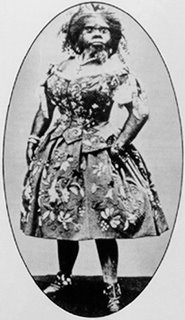Ugly

Known as the ugliest woman in the world, Julia Pastrana (born 1832 in Mexico; died 1860 in Moscow) was a Mexican Digger Indian who at maturity stood 4-and-a-half feet tall. Her face, arms and breast were covered with shiny black hair; she had large ears, a wide, squat nose and enormous nostrils; apelike jaws, each with a double row of teeth (noted by Darwin in The Variations of Animals and Plants under Domestication, 1868); and large deformed lips surmounted by a heavy moustache.
Nevertheless, she had deep black eyes and a graceful figure, and her promoter (later her husband) Frederick Lent, toured her throughout England and Europe wearing fine gowns. When she appeared on stage, people gasped at her hideousness, yet Pastrana maintained enough composure to dance in the style of Lola Montez (albeit with more clothes on) and sing Mexican songs in a small, gentle, nostalgic voice. Offstage, she was known as a curious, well-read, spiritual young woman who spoke three languages and was generous with the money she earned as one of the world's top sideshow attractions. Lent eventually proposed to Pastrana, who accepted without pause, telling critics who cynically accused Lent of doing so merely to secure his relationship with her against rival promoters, that Lent "loves me for my own sake."
While touring in Moscow, she gave birth to their son, whom Pastrana had hoped would bear his father's normal features. Unfortunately, however, the infant turned out to be a gravely ill miniature of herself, and he died within 36 hours. Heartbroken, Pastrana died shortly thereafter. Either crazy from grief or simply greedy, Lent took the corpses of his dead wife and son to a local professor who was an expert in mummification and had their bodies preserved. The mummies were on tour with one operator or another for at least 30 years afterward.
According to eyewitness accounts, the preservation of Pastrana's body was remarkable -- "like an exceedingly good portrait in wax, but it was not formed of wax," said one writer who had once seen Pastrana before she died. If anything, Pastrana was a larger draw in death than in life, accompanied by the mummy of her son. The whereabouts of the bodies of Julia Pastrana and her son were unknown until 1990, when they were rediscovered at the Oslo Forensic Institute.
Labels: Pop Culture





0 Comments:
Post a Comment
Subscribe to Post Comments [Atom]
<< Home